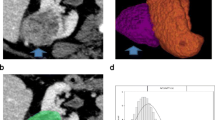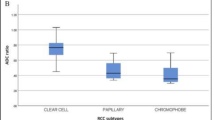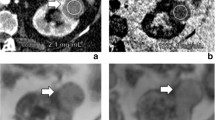Abstract
Objectives
Various imaging methods have been evaluated regarding non-invasive differentiation of renal cell carcinoma (RCC) subtypes. Dual-energy computed tomography (DECT) allows iodine concentration (IC) analysis as a correlate of tissue perfusion. Microvascular density (MVD) in histopathology specimens is evaluated to determine intratumoral vascularization. The objective of this study was to assess the potential of IC and MVD regarding the differentiation between papillary and clear cell RCC and between well- and dedifferentiated tumors. Further, we aimed to investigate a possible correlation between these parameters.
Methods
DECT imaging series of 53 patients with clear cell RCC (ccRCC) and 15 with papillary RCC (pRCC) were analyzed regarding IC. Histology samples were stained using CD31/CD34 monoclonal antibodies; MVD was evaluated digitally. Statistical analysis included performance of Mann-Whitney U test, ROC analysis, and Spearman rank correlation.
Results
Analysis of IC demonstrated significant differences between ccRCC and pRCC (p < 0.001). A cutoff value of ≤ 3.1 mg/ml at IC analysis allowed identification of pRCC with an accuracy of 86.8%. Within the ccRCC subgroup, G1/G2 tumors could significantly be differentiated from G3/G4 carcinomas (p = 0.045). A significant positive correlation between IC and MVD could be determined for the entire RCC cohort and the ccRCC subgroup. Limitations include the small percentage of pRCCs.
Conclusions
IC analysis is a useful method to differentiate pRCC from ccRCC. The significant positive correlation between IC and MVD indicates valid representation of tumor perfusion by DECT.
Key Points
• Analysis of iodine concentration using DECT imaging could reliably distinguish papillary from clear cell subtypes of renal cell cancer (RCC).
• A cutoff value of 3.1 mg/ml allowed a distinction between papillary and clear cell RCCs with an accuracy of 86.8%.
• The positive correlation with microvascular density in tumor specimens indicates correct display of perfusion by iodine concentration analysis.





Similar content being viewed by others
Abbreviations
- AUC:
-
Area under the curve
- ccRCC:
-
Clear cell renal cell carcinoma
- CD:
-
Cluster of differentiation
- chRCC:
-
Chromophobe renal cell carcinoma
- CT:
-
Computed tomography
- DECT:
-
Dual-energy computed tomography
- FOV:
-
Field of view
- H&E:
-
Hematoxylin and eosin
- HU:
-
Hounsfield unit
- kVp:
-
Kilovoltage peak
- MRI:
-
Magnetic resonance imaging
- mTOR:
-
Mammalian target of rapamycin
- MVD:
-
Microvascular density
- pRCC:
-
Papillary renal cell carcinoma
- RCC:
-
Renal cell carcinoma
- ROC:
-
Receiver operating characteristic
- VEGF:
-
Vascular endothelial growth factor
- VNC:
-
Virtual non-contrast
- VNE:
-
Virtual non-enhanced
Reference list
Ljungberg B, Campbell SC, Choi HY et al (2011) The epidemiology of renal cell carcinoma. Eur Urol 60(4):615–621
Muglia VF, Prando A (2015) Renal cell carcinoma: histological classification and correlation with imaging findings. Radiol Bras 48(3):166–174
Capitanio U, Cloutier V, Zini L et al (2009) A critical assessment of the prognostic value of clear cell, papillary and chromophobe histological subtypes in renal cell carcinoma: a population-based study. BJU Int 103(11):1496–1500
Ljungberg B, Bensalah K, Canfield S et al (2015) EAU guidelines on renal cell carcinoma: 2014 update. Eur Urol 67(5):913–924
Novara G, Martignoni G, Artibani W, Ficarra V (2007) Grading systems in renal cell carcinoma. J Urol 177(2):430–436
Nico B, Benagiano V, Mangieri D, Maruotti N, Vacca A, Ribatti D (2008) Evaluation of microvascular density in tumors: pro and contra. Histol Histopathol 23(5):601–607
Meert AP, Paesmans M, Martin B et al (2002) The role of microvessel density on the survival of patients with lung cancer: a systematic review of the literature with meta-analysis. Br J Cancer 87(7):694–701
Vikram R, Ng CS, Tamboli P et al (2009) Papillary renal cell carcinoma: radiologic-pathologic correlation and spectrum of disease. Radiographics. 29(3):741–754 discussion 755–747
Young JR, Margolis D, Sauk S, Pantuck AJ, Sayre J, Raman SS (2013) Clear cell renal cell carcinoma: discrimination from other renal cell carcinoma subtypes and oncocytoma at multiphasic multidetector CT. Radiology. 267(2):444–453
Hotker AM, Mazaheri Y, Wibmer A et al (2017) Differentiation of clear cell renal cell carcinoma from other renal cortical tumors by use of a quantitative multiparametric MRI approach. AJR Am J Roentgenol 208(3):W85–W91
Graser A, Johnson TR, Chandarana H, Macari M (2009) Dual energy CT: preliminary observations and potential clinical applications in the abdomen. Eur Radiol 19(1):13–23
Graser A, Becker CR, Staehler M et al (2010) Single-phase dual-energy CT allows for characterization of renal masses as benign or malignant. Invest Radiol 45(7):399–405
Weidner N, Semple JP, Welch WR, Folkman J (1991) Tumor angiogenesis and metastasis--correlation in invasive breast carcinoma. N Engl J Med 324(1):1–8
Weidner N (1995) Intratumor microvessel density as a prognostic factor in cancer. Am J Pathol 147(1):9–19
Kroeger N, Choueiri TK, Lee JL et al (2014) Survival outcome and treatment response of patients with late relapse from renal cell carcinoma in the era of targeted therapy. Eur Urol 65(6):1086–1092
Ascenti G, Mileto A, Krauss B et al (2013) Distinguishing enhancing from nonenhancing renal masses with dual-source dual-energy CT: iodine quantification versus standard enhancement measurements. Eur Radiol 23(8):2288–2295
Lubner MG, Stabo N, Abel EJ, Del Rio AM, Pickhardt PJ (2016) CT textural analysis of large primary renal cell carcinomas: pretreatment tumor heterogeneity correlates with histologic findings and clinical outcomes. AJR Am J Roentgenol 207(1):96–105
Mileto A, Marin D, Alfaro-Cordoba M et al (2014) Iodine quantification to distinguish clear cell from papillary renal cell carcinoma at dual-energy multidetector CT: a multireader diagnostic performance study. Radiology. 273(3):813–820
Hsieh JJ, Purdue MP, Signoretti S et al (2017) Renal cell carcinoma. Nat Rev Dis Primers 3:17009
Apfaltrer P, Meyer M, Meier C et al (2012) Contrast-enhanced dual-energy CT of gastrointestinal stromal tumors: is iodine-related attenuation a potential indicator of tumor response? Invest Radiol 47(1):65–70
Hellbach K, Sterzik A, Sommer W et al (2016) Dual energy CT allows for improved characterization of response to antiangiogenic treatment in patients with metastatic renal cell cancer. Eur Radiol 27:2532–2537
Cheng SH, Liu JM, Liu QY et al (2014) Prognostic role of microvessel density in patients with renal cell carcinoma: a meta-analysis. Int J Clin Exp Pathol 7(9):5855–5863
Zocchi MR, Poggi A (2004) PECAM-1, apoptosis and CD34+ precursors. Leuk Lymphoma 45(11):2205–2213
Jinzaki M, Tanimoto A, Mukai M et al (2000) Double-phase helical CT of small renal parenchymal neoplasms: correlation with pathologic findings and tumor angiogenesis. J Comput Assist Tomogr 24(6):835–842
Jiang Y, Li J, Wang J et al (2016) Assessment of vascularity in hepatic alveolar echinococcosis: comparison of quantified dual-energy CT with histopathologic parameters. PLoS One 11(2):e0149440
Young JR, Coy H, Douek M et al (2017) Type 1 papillary renal cell carcinoma: differentiation from type 2 papillary RCC on multiphasic MDCT. Abdom Radiol (NY) 42(7):1911–1918
Graser A, Johnson TR, Hecht EM et al (2009) Dual-energy CT in patients suspected of having renal masses: can virtual nonenhanced images replace true nonenhanced images? Radiology. 252(2):433–440
Funding
The authors state that this work has not received any funding.
Author information
Authors and Affiliations
Corresponding author
Ethics declarations
Guarantor
The scientific guarantor of this publication is Michael Staehler.
Conflict of interest
The authors of this manuscript declare no relationships with any companies whose products or services may be related to the subject matter of the article.
Statistics and biometry
No complex statistical methods were necessary for this paper.
Informed consent
Written informed consent was obtained from all subjects (patients) in this study.
Ethical approval
Institutional Review Board approval was obtained.
Methodology
• Retrospective
• Experimental
• Performed at one institution
Additional information
Publisher’s note
Springer Nature remains neutral with regard to jurisdictional claims in published maps and institutional affiliations.
Electronic supplementary material
ESM 1
(DOCX 15.0 mb)
Rights and permissions
About this article
Cite this article
Marcon, J., Graser, A., Horst, D. et al. Papillary vs clear cell renal cell carcinoma. Differentiation and grading by iodine concentration using DECT—correlation with microvascular density. Eur Radiol 30, 1–10 (2020). https://doi.org/10.1007/s00330-019-06298-2
Received:
Revised:
Accepted:
Published:
Issue Date:
DOI: https://doi.org/10.1007/s00330-019-06298-2




